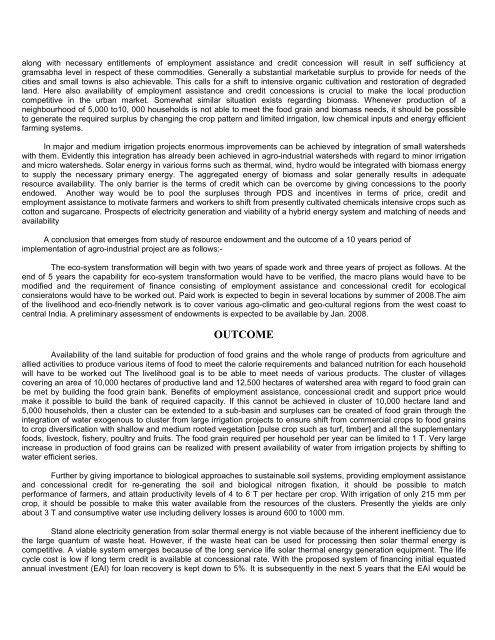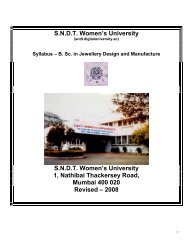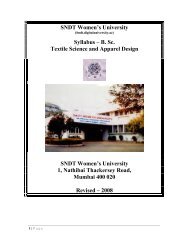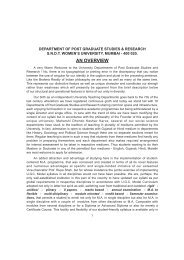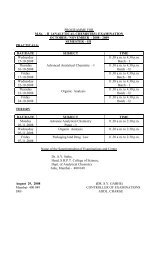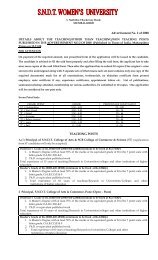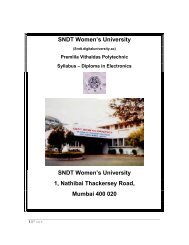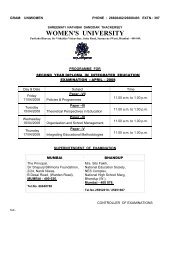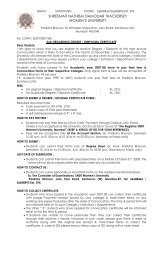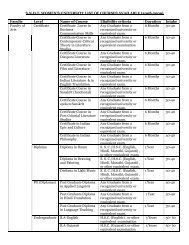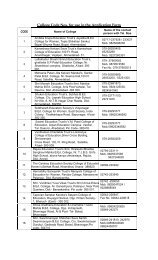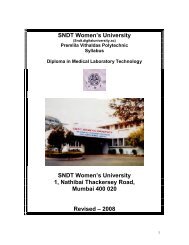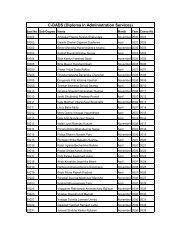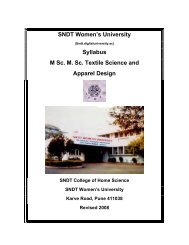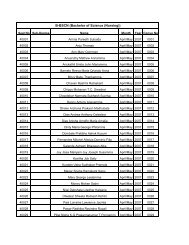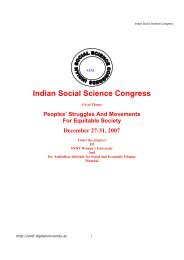XXXI Abstracts Part 1 page 1-189
XXXI Abstracts Part 1 page 1-189
XXXI Abstracts Part 1 page 1-189
You also want an ePaper? Increase the reach of your titles
YUMPU automatically turns print PDFs into web optimized ePapers that Google loves.
along with necessary entitlements of employment assistance and credit concession will result in self sufficiency at<br />
gramsabha level in respect of these commodities. Generally a substantial marketable surplus to provide for needs of the<br />
cities and small towns is also achievable. This calls for a shift to intensive organic cultivation and restoration of degraded<br />
land. Here also availability of employment assistance and credit concessions is crucial to make the local production<br />
competitive in the urban market. Somewhat similar situation exists regarding biomass. Whenever production of a<br />
neighbourhood of 5,000 to10, 000 households is not able to meet the food grain and biomass needs, it should be possible<br />
to generate the required surplus by changing the crop pattern and limited irrigation, low chemical inputs and energy efficient<br />
farming systems.<br />
In major and medium irrigation projects enormous improvements can be achieved by integration of small watersheds<br />
with them. Evidently this integration has already been achieved in agro-industrial watersheds with regard to minor irrigation<br />
and micro watersheds. Solar energy in various forms such as thermal, wind, hydro would be integrated with biomass energy<br />
to supply the necessary primary energy. The aggregated energy of biomass and solar generally results in adequate<br />
resource availability. The only barrier is the terms of credit which can be overcome by giving concessions to the poorly<br />
endowed. Another way would be to pool the surpluses through PDS and incentives in terms of price, credit and<br />
employment assistance to motivate farmers and workers to shift from presently cultivated chemicals intensive crops such as<br />
cotton and sugarcane. Prospects of electricity generation and viability of a hybrid energy system and matching of needs and<br />
availability<br />
A conclusion that emerges from study of resource endowment and the outcome of a 10 years period of<br />
implementation of agro-industrial project are as follows:-<br />
The eco-system transformation will begin with two years of spade work and three years of project as follows. At the<br />
end of 5 years the capability for eco-system transformation would have to be verified, the macro plans would have to be<br />
modified and the requirement of finance consisting of employment assistance and concessional credit for ecological<br />
consieratons would have to be worked out. Paid work is expected to begin in several locations by summer of 2008.The aim<br />
of the livelihood and eco-friendly network is to cover various ago-climatic and geo-cultural regions from the west coast to<br />
central India. A preliminary assessment of endowments is expected to be available by Jan. 2008.<br />
OUTCOME<br />
Availability of the land suitable for production of food grains and the whole range of products from agriculture and<br />
allied activities to produce various items of food to meet the calorie requirements and balanced nutrition for each household<br />
will have to be worked out The livelihood goal is to be able to meet needs of various products. The cluster of villages<br />
covering an area of 10,000 hectares of productive land and 12,500 hectares of watershed area with regard to food grain can<br />
be met by building the food grain bank. Benefits of employment assistance, concessional credit and support price would<br />
make it possible to build the bank of required capacity. If this cannot be achieved in cluster of 10,000 hectare land and<br />
5,000 households, then a cluster can be extended to a sub-basin and surpluses can be created of food grain through the<br />
integration of water exogenous to cluster from large irrigation projects to ensure shift from commercial crops to food grains<br />
to crop diversification with shallow and medium rooted vegetation [pulse crop such as turf, timber] and all the supplementary<br />
foods, livestock, fishery, poultry and fruits. The food grain required per household per year can be limited to 1 T. Very large<br />
increase in production of food grains can be realized with present availability of water from irrigation projects by shifting to<br />
water efficient series.<br />
Further by giving importance to biological approaches to sustainable soil systems, providing employment assistance<br />
and concessional credit for re-generating the soil and biological nitrogen fixation, it should be possible to match<br />
performance of farmers, and attain productivity levels of 4 to 6 T per hectare per crop. With irrigation of only 215 mm per<br />
crop, it should be possible to make this water available from the resources of the clusters. Presently the yields are only<br />
about 3 T and consumptive water use including delivery losses is around 600 to 1000 mm.<br />
Stand alone electricity generation from solar thermal energy is not viable because of the inherent inefficiency due to<br />
the large quantum of waste heat. However, if the waste heat can be used for processing then solar thermal energy is<br />
competitive. A viable system emerges because of the long service life solar thermal energy generation equipment. The life<br />
cycle cost is low if long term credit is available at concessional rate. With the proposed system of financing initial equated<br />
annual investment (EAI) for loan recovery is kept down to 5%. It is subsequently in the next 5 years that the EAI would be


